Explanation of highlights
update:2024/4/11
- Introduction of the new Bank of Japan notes
- Stanhope Printing Press
- History of anti-counterfeiting technology: Printing and paper manufacturing technologies
- Q&A corner, photo spot
- Evolution of banknotes
- Unusual banknotes of the world
- Banknotes of the world
- Evolution of stamps
- Stamps of the world
- Passports, the Official Gazette, and securities
- History of the National Printing Bureau
- The art on the banknotes
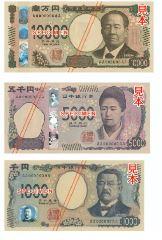
The new Bank of Japan notes(specimen)
Introducing the design and anti-counterfeiting technology of the new Bank of Japan notes that will be issued on July 3, 2024.
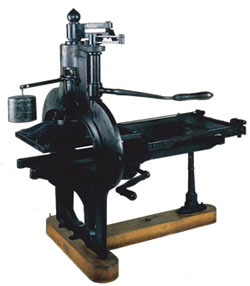
This item is designated as a National Important Cultural Property and as a relic that symbolizes the arrival of modern printing technology in Japan.
Special methods have been used in the papermaking and printing process to prevent counterfeiting since the world’s first banknotes were manufactured.
This section introduces printing technologies that marked the dawn of modernization and papermaking technologies include raw materials for banknote paper used in Japan in comparison with those of other countries.
(1)Printing technology: Original plate engraving technology
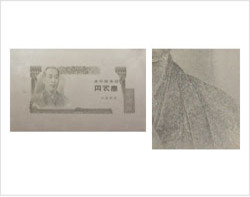
Intaglio plate engraving for banknotes and printed matters
Since ancient times, banknotes have been printed with intricate patterns to enhance their anti-counterfeiting effect, but woodblock printing and other techniques were limited in their ability to reproduce such patterns.
In the modern era, the technologies for producing fine patterns progressed dramatically, and new technologies were introduced. One such technology is the “intaglio engraving,” in which portraits and other designs are engraved by hand directly on copper plates using artisanal techniques.
This technology is still used today as the original plate engraving technique for banknotes and is so precise that more than ten lines can be engraved in a width of one millimeter.
(2)Papermaking technology: Watermarking technologies
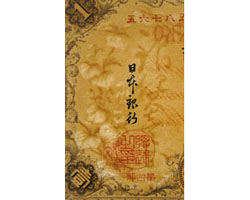
Convertible Bank of Japan note, 1 yen, issued in 1889 (partial enlargement).
The light-and-shaded watermark first used on modern Japanese banknotes
Paper for banknotes is watermarked to prevent counterfeiting. Watermark has been used on banknotes since the Edo era. “Light-and-shaded watermark” technology, developed in the Meiji era, reproduces a gradation of light and dark patterns when the paper is exposed to light. This technology is still used today for anti-counterfeiting, and its sophistication has become a distinctive feature of Japanese banknotes.![]()
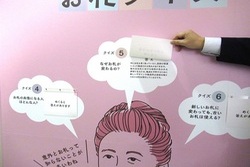
At the Q&A Corner, you can enjoy learning trivia about banknotes using a quiz format.
The photo spot is an AR (Augmented Reality) photo spot where the image of “Shibusawa kun,” a character of Kita city, Tokyo, whose model is Eiichi Shibusawa, the portrait on the new 10,000 yen note, appears.
Why not take a picture to commemorate your visit to the Museum?
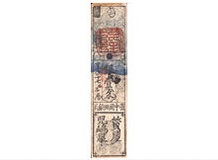
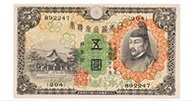
Early notes of the world, Japanese notes during the Edo era, and modern to contemporary Japanese banknotes are on display here.
You can view all major modern and contemporary Japanese banknotes.
China was thew first to use notes at the end of the 10th century.
It was about 600 years later that notes appeared in Japan and Europe.
The size and design of these early notes were quite different from those of today, which may come as a surprise.
In the 19th century, banknote printing technology was modernized, and the banknote designs we are accustomed to seeing today were created.
Please look at the banknotes of that time to see how Japanese banknotes were modernized at a stroke during the Meiji Restoration period.
Then, please look at the Japanese banknotes of the Meiji, Taisho, Showa, and Heisei eras, displayed in chronological order, and observe how the designs have changed with the advancement of printing technology and social changes.
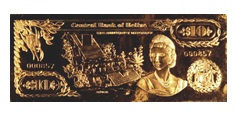
Gold leaf banknote, Belize, 10 dollars, issued in 1984
There are banknotes of various materials, sizes, and designs in the world.
The exhibition features a selection of rare and unique notes.
There are banknotes made of cloth, banknotes the size of postage stamps, and ultra-high denomination banknotes issued at the time of hyperinflation.
Unusual banknotes have special social and economic backgrounds.
A country issued gold leaf banknotes as souvenirs. Unique banknote designs that represent the traditions and tastes of the country and its people must be viewed.
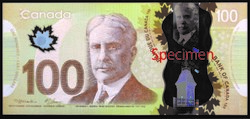
Bank of Canada note, 100 dollars, issued in 2011
A total of 158 world banknotes (banknotes of countries and currency unions such as Euro) are on display.
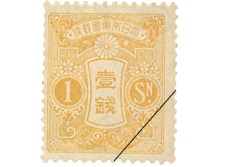
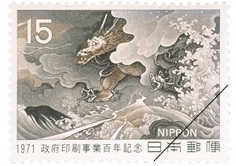
This section displays Japanese postage stamps from past generations and rare postage stamps of the world.
Stamps are also called “small works of art.”
The technology used to beautifully print elaborate designs on such a small area has changed with the demands of the times.
During the Meiji and Taisho eras, preventing counterfeits was primarily focused on.
There came an era when only limited technologies were available in emergencies due to earthquakes and wars.
Rapid economic growth was observed when technologies were improved in response to the stamp boom.
Please look at the changes in stamp design and technology that have accompanied Japanese politics and economics.
In the “Rare stamps of the world” section, you can compare them with Japanese stamps: the world’s largest stamps, which are larger than a postcard, stamps with a smell, stamps made of materials other than paper, etc.
You will see a world different from the “commonality” of Japanese stamps.
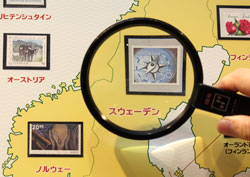
This section introduces stamps issued in countries or regions around the world.
Stamps are also issued in such places!
Looking around the world, there are countries where remote islands and overseas territories issue their own stamps. There are also stamps issued by the United Nations and Antarctica.
Each country’s stamp design and issuance policy may include an intention to promote sales to collectors at home and abroad (i.e., to earn foreign currency).
Therefore, although some countries express their national character by depicting their industries, animals, etc. on their stamp designs, others adopt popular themes (foreign actors, world heritage sites, etc.) even if they are not related to the country.
Around 280 stamps from various countries together with a world map allow visitors to enjoy a trip around the world of stamps while appreciating the diverse designs.
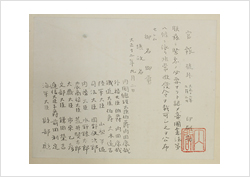
This section introduces the history of passports, the Official Gazette, revenue stamps, and government bonds manufactured by the National Printing Bureau.
The Official Gazette is a means of national public notice and published every day except Saturdays, Sundays, and national holidays.
Laws become effective only after they are published in the Official Gazette.
The Official Gazette issued on September 2, 1923, used handwritten mimeograph printing.
The Great Kanto Earthquake destroyed the Bureau’s facility, and the Official Gazette could not be printed.
The handwritten text, which is said to be written with the help of candlelight at that time, illustrates the importance of the Official Gazette.
Other items on display include previous passports, and government bonds that are now dematerialized.
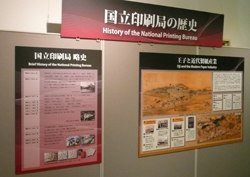
The history of the National Printing Bureau is introduced in panels.
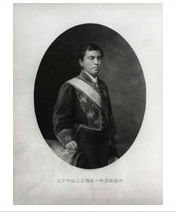
Banknote design is an important element in adding dignity and grace to a banknote as currency. This section focuses on the artistic aspects of banknote designs.
This is an engraved portrait of Lord Takayoshi Kido, the elder statesperson of the Meiji era.
It was engraved using a technique that continues to be used today as the original plate engraving technique for banknotes.
The creator was Edoardo Chiossone, who introduced modern banknote manufacturing technology to Japan.
The creator, who originally worked in the field of reproduction prints of artworks, used minute lines and dots to realistically depict Kido’s face and clothes.
Moreover, the workmanship conveys Kido’s personality as well as his appearance.
This expressive power creates an aesthetic effect, and because it is difficult to reproduce the fine engraved lines, it has an anti-counterfeiting effect as well.
This is why the technique was used for the original engraving of banknotes.
By the way, many historical figures are portrayed on previous banknotes, but if the person was a legendary figure, or an existed person without a photo, the individual was portrayed as a model of a real person.
Takayoshi Kido was used as a model for the portrait on the banknote. Using this portrait print as a clue, it is fun to look for the face on the banknote in the “Evolution of banknotes” section.
